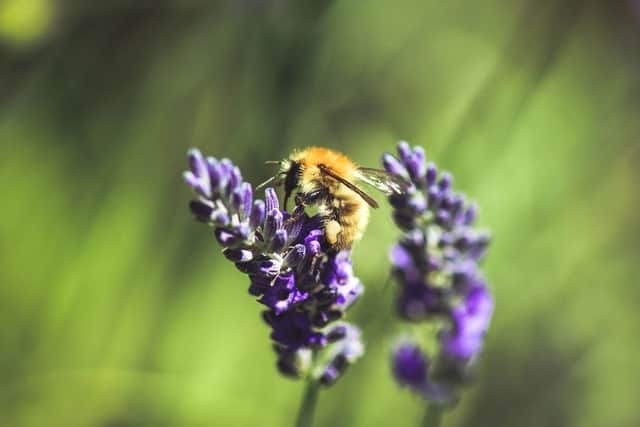We all know that bees are important to our environment. Bees pollinate 80% of our crops and perform $15 billion in ecological services in the United States alone.
However, In only one quarter of 2018, we lost 16% of honeybee colonies. This fact and similar statistics are a major cause for concern.
If you want to help pollinators and slow their decline, attracting mason bees is a great start. Named for their preference of using mud to build nests (like brick masons), these small bees are important and low-maintenance pollinators.
If you have a lush garden, crops, or even an orchard, you can benefit from the pollination of mason bees.
Table of Contents
What are Masonry bees?
The mason bee is the common name for the species of bee in the genus Osmia, part of the Megachilidae family.
This family of bees is also referred to as ‘orchard mason bees’ or ‘blue orchard bees’.
They get their name from their habit of using mud and other “masonry” materials to construct and build their nests. These nests can usually be found between the cracks of stones and other dark, small cavities.
Unlike other species of bee, mason bees do not make honey, and are solitary bees, which means they do not live in colonies or serve a queen.
Each female mason bee is fertile and makes her own nest, and no worker bees exist within this species.
They are native to North America and are amongst the easiest bees to raise, and are great at their job of pollinating.
Keep reading to learn how to attract mason bees to your yard.
Why Attract Mason Bees?
Mason bees are less popular than their European honeybee counterparts. They don’t produce honey, beeswax, or other highly-coveted bee products. However, when it comes to pollination, mason bees have honeybees beat.
Mason bees are solitary, with each female having the ability to form her own nest. There are no worker bees to support her. Because mason bees focus on single nests and don’t produce honey, they are a more productive pollinator.
Here are a few other reasons why mason bees are better pollinators than honeybees:
- The mason bee is active at lower temperatures than honeybees, making them more resilient to cold spells
- The mason bee needs to visit 1600 to 2400 blossoms a day for nest-building
- The mason bee collects pollen on their abdomen and spread it more readily, pollinating fruit trees like apple, pear, plum, and cherry trees.
- The mason bee collects nectar and pollen at the same time, whereas honeybees focus on one or the other
Mason bees are not only more productive, but they’re also low maintenance. It’s easy to construct their nests from everyday objects, and they need little upkeep.
They are also easy to cultivate, store, and ship for commercial purposes.
Mason bees are great for those worried about the pain behind beekeeping. Mason bees are docile by nature and rarely sting. When they do sting, their stinger does not contain barbs and is not painful. This means that you’ll need little to no protective equipment is required when attracting mason bees.
Last, although European honeybees are being plagued by varroa mites, mason bees are immune to the pest.
How to Attract Mason Bees
Here are steps, tips, and tricks to attracting mason bees to your orchard, garden, or crops:
Bring them home in the Spring
Mason bees are most active in the spring, between the months of February and May within the United States. If you are purchasing mason bees, it is best to bring them to your home during their peak activity levels. This will assure there is the most pollen/nectar available for them to survive and reproduce.
Provide a Great Habitat
To attract or keep mason bees in your yard, you’ll need to give them a great reason to stay.
Housing
Mason bees build their nests in tunnels, encasing and closing them shut with mud. You can either encourage natural mason bee nesting or provide artificial housing.
Using an untreated piece of wood, you may drill 0.3 inch holes 6 inches deep. These tunnels are then used for nesting. You can alternatively use thick paper straws, hollow reeds, or straw. You can also buy commercial nesting units, as a more durable option. Mount this mason bee house should 4-7 feet off of the ground, in a location that receives warm morning sun but also protection from the elements.
Because the bees need mud for their nests, you’ll also need to provide a consistent supply of mud nearby. Be sure the mud hole isn’t placed right below the nests, as clumsy newborn mason bees may drown.
Foraging
Mason bees need a lot of flowers to stay satisfied on your property. Make sure that food sources are within 200-300 feet of their nests.
Your plants should have blue, purple, or yellow flowers in a composite (open petals) form, which is their preferred flower type. Be sure to avoid any pesticides, or use eco-friendly options when possible. Pesticides and mites are the leading causes of honeybee declines across the world. Avoid pesticides whenever possible.
To encourage a period of longer foraging, you can also grow plants that bloom later in the spring, such as roses. By maintaining a constant pollen supply, you’ll be sure the mason bees stick around rather than begin a search for new territory.
Yearly Maintenance
Thankfully, mason bees need very little maintenance. If they have plenty of flowers and mud, you’ll find them to be quite successful.
However, if you choose to continue the population, you’ll need to move the nesting box. Once a year, in the fall, you will need to remove the nest boxes and store them in a dark, enclosed space. This space can be a garage or a shed. This will prevent the eggs from freezing, or avian predators eating them. In early spring, before plants begin to blossom, you can return the nests to their original location and enjoy the new generation of pollinators.
What Do Mason Bees Eat?
Unlike honey bees, masonry bees do not make their own honey. They eat pollen and nectar throughout their lives as they begin to forage from flower to flower.
Final Thoughts on Attracting Mason Bees
Mason bees are the underrated relatives of honeybees. Although they don’t produce commercial products like honey or beeswax, they pollinate better than their honeybee counterparts.
If you have an orchard, garden, or crop, the details above outline exactly how to attract mason bees this spring. If you provide the bees with good housing and ample foraging, you will have a healthy, growing population of mason bees in no time.
For information on how to get started with regular-style beekeeping, visit our blog post on how to start beekeeping.

